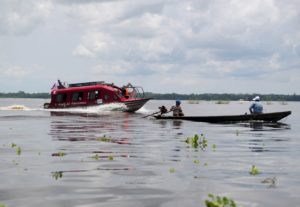
Iquitos, Peru, Mar 6 (EFE).- A small, garnet-colored boat has begun navigating parts of Peru’s Amazon region as part of a crucial mission: to halt the worrying spread of HIV (human immunodeficiency virus) among the local indigenous population.
Launched Tuesday by Los Angeles-based non-profit AIDS Healthcare Foundation (AHF) in Iquitos, a hot and bustling northern city that is the largest in the Peruvian Amazon but only accessible by plane or boat, the vessel will provide educational information and conduct diagnostic tests aimed at saving the lives of hundreds or even thousands of people.
“We can’t wait for people already very sick with AIDS (Acquired Immunodeficiency Syndrome) to come for treatment. We need to go to where the people are to get the tests to them quickly, and the only way to do that in this part of the continent is by river,” the head of AHF’s office for Latin America and the Caribbean, Patricia Campos, told EFE.
“Getting to remote places, diagnosing (the illness) and providing antiretroviral treatment make the difference between life and death,” the director of AHF Peru, Jose Luis Sebastian, told EFE.
The boat is called “Angely del Amazonas,” in honor of a 9-year-old girl who was found with late-stage HIV/AIDS after she had received treatment from a local healer.
“Her case hit us hard. We felt that if the diagnosis had been made earlier the girl wouldn’t have had to die,” Sebastian said after the boat’s inaugural journey – a visit to the so-called “Venice of Iquitos,” a neighborhood in the city’s Belen district that experiences severe flooding when the level of the Amazon River rises.
Subsequent trips will take the boat down the Amazon as far as the triple border shared by Peru, Colombia and Brazil, an area that is home to hundreds of indigenous communities.
In these remote parts of the vast Amazon plain, access to a condom or an antiretroviral treatment typically requires a day-long trip on board a rustic wooden boat known as a “peque-peque.”
The Angely del Amazonas will seek to change this reality by distributing condoms, providing information about HIV transmission (through pre-seminal fluid, semen, vaginal fluid, blood and breast milk), conducting diagnostic tests and ensuring that patients are up to speed with their treatment.

The task might seem simple, but intercultural barriers make it much more complicated, Sebastian said, noting that the condom is not generally accepted due to a lack of information.
“Then infections like HIV do not fit in (indigenous people’s) conception of diseases. Since it doesn’t exist in their medicine, they don’t know how to confront it,” the expert said.
“We’ll probably have to forge alliances with the healers and shamans to create a stronger system with new characteristics so people access the medicine and save their lives,” he added.
The boat also will help expand knowledge of HIV incidence among Peru’s indigenous population, since the only in-depth investigation to date was carried out among the Awajun and Wampis in the northeastern province of Condorcanqui, which borders Ecuador.
“More than 25,000 diagnostic tests were conducted, representing 50 percent of the population in that area, and 1 percent tested positive for HIV, compared to a national average of 0.4 percent,” the director of HIV/AIDS Prevention and Control at Peru’s Health Ministry, Carlos Benites, told EFE.
HIV incidence among the Awajun is similar to that of Peruvian sex workers, although far from the rate seen with transsexuals (20 percent) and gays (12 percent) in that Andean nation, a country where an estimated 72,000 people are infected with the virus.
In the case of indigenous people, Benites said that besides low condom use and limited access to health services, other factors that contribute to the spread of the virus are early onset of sexual activity and a high number of sexual partners.
HIV infections in indigenous communities normally occur because “the men travel to the cities, have sexual relations, become infected, and when they return to the community they begin to transmit” the virus, Sebastian said.
Due to a lack of pre-natal care, mothers also can pass the infection to their babies, he added.
Despite the challenges, AHF is determined to make sure that poverty is not an obstacle to treatment and even displays a message of inclusiveness on the Angely del Amazonas: “medicine and advocacy for all users, regardless of their ability to pay.”
